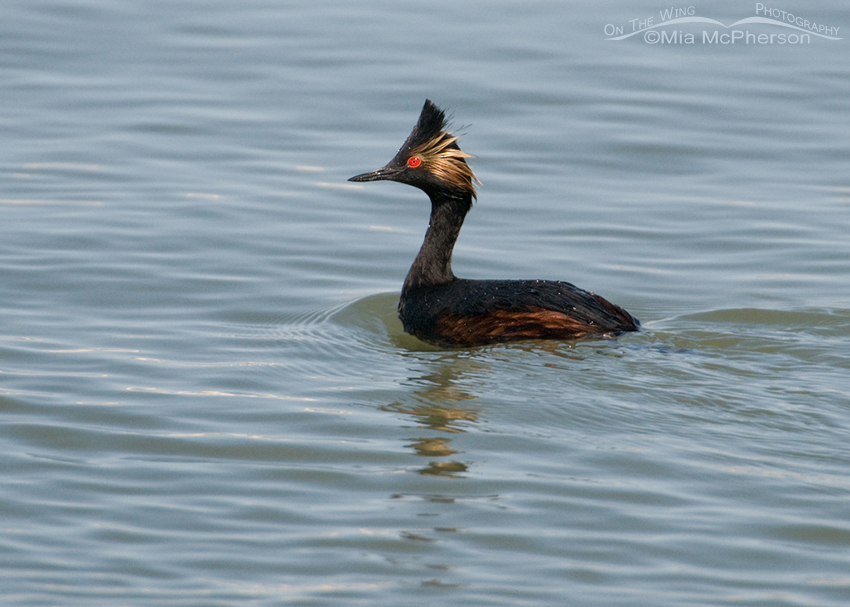During spring and fall migration there can be so many Eared Grebes (Podiceps nigricollis) on the Great Salt Lake that they are impossible to count.
 Eared Grebes on the Great Salt Lake – Nikon D200, handheld, f9, 1/1000, ISO 400, Nikkor 18-200mm VR at 130mm, natural light
Eared Grebes on the Great Salt Lake – Nikon D200, handheld, f9, 1/1000, ISO 400, Nikkor 18-200mm VR at 130mm, natural light
The diet of Eared Grebes include brine shrimp and alkali flies that are found in hyper saline environments such as Mono Lake in California and the Great Salt Lake in Utah. For most of the year Eared Grebes and Wilson’s Phalaropes are the two bird species that spend the most time in highly saline environments.
It is amazing to stop on the causeway to Antelope Island State Park and see thousands upon thousands of Eared Grebes. Yesterday day most of the grebes were north of the causeway and even with my high-powered lens I couldn’t see where the birds stopped.
 Eared Grebe in breeding plumage – Nikon D300, f6.3, 1/2500, ISO 640, +0.3 EV, Nikkor 200-400mm VR with 1.4x TC at 400mm, natural light
Eared Grebe in breeding plumage – Nikon D300, f6.3, 1/2500, ISO 640, +0.3 EV, Nikkor 200-400mm VR with 1.4x TC at 400mm, natural light
I think that Eared Grebes are gorgeous in breeding plumage with their primarily dark body and neck combined with the dark head in contrast to the wispy yellow plumes and cherry red eye. I like that crest too!
My portfolio is seriously lacking in Eared Grebe images, something I should remedy.
Life is good.
Mia
Click here to see more of my Eared Grebe photos plus facts and information about this species.


Great photo Mia.. I wonder what it must be like to be an Eared Grebe and find oneself surrounded by like-minded birds..secure is the word that comes to mind.
They are gorgeous birds Mia and you have captured them very well. I feel like I’ve been given a treat when I get to see one here in Northern California. Love the color contrast.
Larry, I agree, they are gorgeous birds. I feel so lucky to get to see so many of them in one place. Thanks for your comment.
What a gorgeous little bird!
Julie, they are gorgeous birds. Thank you!
That’s a lot of grebes! Stunning photos as usual Mia. Love that red eye!!
Stunning photos as usual Mia. Love that red eye!!
Thank you Linda, it is a wonderful sight!
It’s amazing how many are out there!
Judy, it really is amazing to see how many Eared Grebes there are on the Great Salt Lake at certain seasons. Takes my breath away at times.
Wow!! Just… Wow!
Thank you Nicole, good to “see” you again!
Wow!!! What a sight! Beautiful birds and excellent work as always, Mia!
Thanks for your very kind comment Beverly!
Wow, what a beautiful sight that is! They are especially stunning in their breeding plumage. Super photographs!
Thank you Julie, Eared Grebes are very stunning in breeding plumage!
I love that red too. Carol
Thanks Carol, that red reminds me of Marashino Cherries and I love them!
Good grief! That’s too cool. Maybe with birds it isn’t possible to have too much of a good thing.
Laurence, I don’t think it is possible to have too many birds unless they are pooping on your car! Thanks for your comment.
Mia:
I’m green with envy. We don’t see these in their beautiful breeding plumage here in Pensacola. I chased a single bird in breeding plumage around a pond in Arizona for two days but never got close enough for a good shot. I enjoyed seeing your photos AND reading the associated text.
Dave
Dave, you will have to visit some time during the spring or fall and see the millions of Eared Grebes, it is almost unbelievable how many there can be. Thanks so much for commenting!
WOW
nature never ceases to amaze.
And, i agree: very handsome birds
Zephyr, I still can’t get a grasp on how many Eared Grebes there can be on the Great Salt Lake, it is breathtaking. Thanks for commenting!